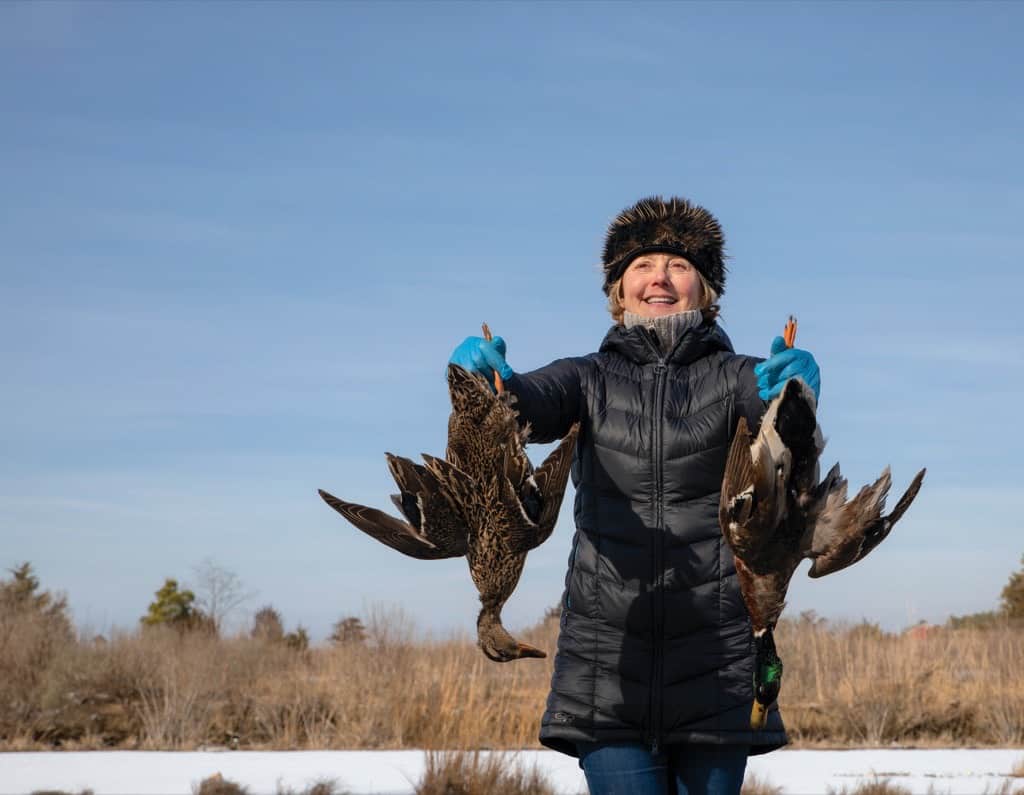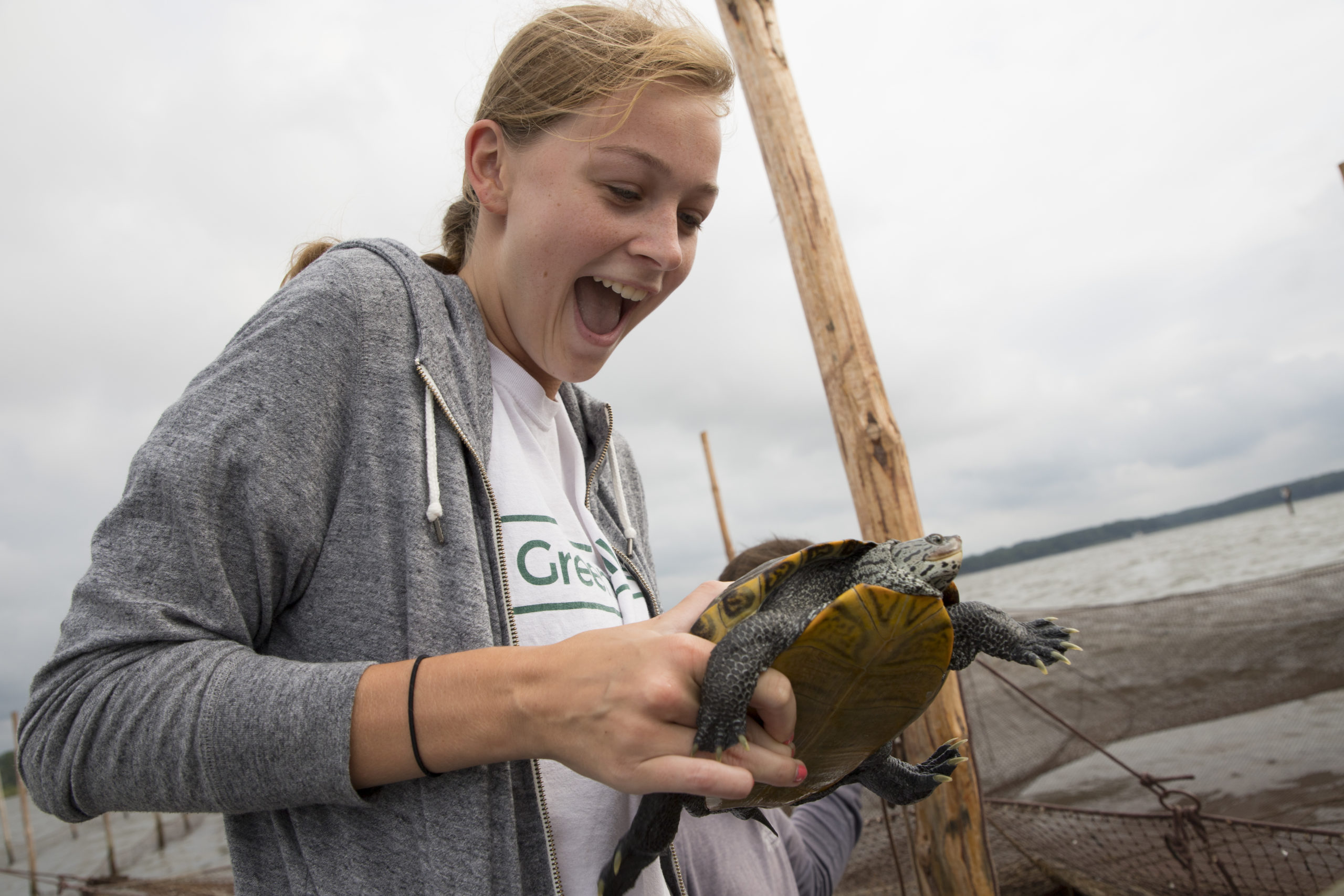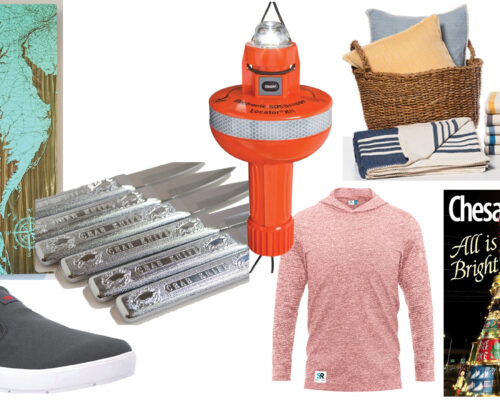A ladies’ weekend that gets a little wild
We looked like bundled-up surgeons huddled over outdoor operating tables somewhere in the Great North. In truth, we were gathered on a hunting preserve on Maryland’s Eastern Shore in the aftermath of a pesky snowfall. Having left a toasty hunting lodge, 14 other ladies and I were getting our penultimate lesson in becoming culinary outdoorswomen. Our challenge? Learn how to cut the breast from a duck that we had, in theory, shot in the marshes on this frosty February day.
Like most of our group, I had never hunted. I didn’t attend the Becoming an Outdoors-Woman workshop offered by the Maryland Department of Natural Resources to become a hunter necessarily. But if you’re going to eat wild game (which I love) I figure you owe it to yourself and your meal to understand and honor the entire process, including the messier parts that happen in the field in inclement weather.
Picking up a mallard hen and a sharp knife at one of the communal tables, I tried to follow lodge manager Vicky Mullaney’s instructions. Placing the duck on its back, I felt for its breastbone. My fingers numb with cold, I pulled the downy feathers away to reveal the protruding bone. It was surprisingly easy. Like plucking a leaky pillow. The field surgery proved a bit more challenging.
With the hen’s breastbone cleaned of its surrounding fluff, I inserted the knife and cut down along the bone, beginning with the right half of the breast and then switching to the left. Reaching into the cavity, I pulled the dark red meat away from the bone and then carefully cut out each palm-sized chunk of breast.
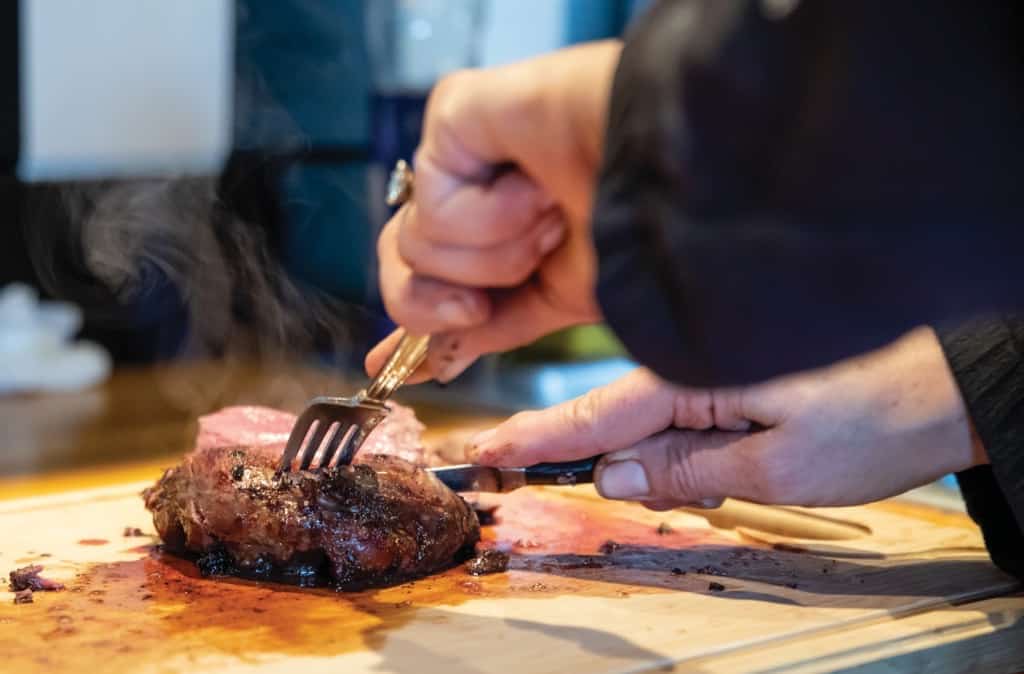
Thankfully, I received expert guidance from Mullaney’s assistant, Lauren Cameron, as I maneuvered the knife and tried to extract reasonably intact breast halves. Cameron, a former Miss Outdoors from Dorchester County, knows how to field dress animals, having skinned muskrats—among other skills—en route to earning her crown.
By the time we had finished, all of us wore red badges of outdoorsyness in the form of bloodstained fingertips. The crimson smears even sullied one woman’s glitter-polished fingernails, yet nobody seemed squeamish about getting hands-in with deceased ducks. As one of our group explained: “You just gotta own it.”
We deposited the last of the excised duck breasts in bowls, to be cleaned and cooked later by Mullaney. Then we returned to our indoor classroom at The Lodge at Black Pearl, the Mullaney family’s private lodge and home that for about 10 weeks every winter caters to invited waterfowlers who travel from across the country to hunt ducks and geese on the surrounding marshes and to eat hearty meals (bacon breakfast sandwiches, duck and sausage gumbo, beef tenderloin and coq au vin) that Mullaney prepares in the lodge’s professional-grade kitchen.
Mullaney and her husband bought the rustic, 850-acre retreat from a Washington D.C. lobbyist and raised five children there, teaching them the value of an outdoors lifestyle and the health benefits of a high-protein, low-fat fish and game diet. “If you shoot it, you eat it” is the Mullaney mantra.
“It’s definitely part of what my family does together,” she said of hunting. “It’s why we bought this place; I knew my boys [she has three] would come home no matter who they married—and they did.” In fact, she told us, her newest daughter-in-law shot a deer just the day before. “It’s not just about the kill and shooting. It’s about spending time together. It just becomes a way of life.” The Mullaney daughters are as outdoorsy as their parents and siblings. Partnering with DNR on her second Becoming an Outdoors-Woman (BOW) workshop, Mullaney shared with us her living-from-the-land philosophy, its savory, practical applications—the meals she makes for her family and guests.
Designed to teach outdoor skills to women in a reduced-testosterone environment, BOW workshops originated some 30 years ago in Wisconsin and have expanded nationwide. Maryland’s program, which began in 1995, offers eight to 10 workshops a year, including a popular rockfishing clinic in June and an equally popular deer clinic and hunt in November. Other offerings vary annually, but over the years, distaff Marylanders have learned how to fly-fish and bow hunt, keep bees and can vegetables, use a muzzleloader and wield a chainsaw, identify edible wild plants and track elusive wild turkeys.
Our session was what DNR calls a “Beyond BOW” workshop, intensive classes co-hosted with another organization such as Black Pearl Lodge that focuses on specific activities. Our From Field to Table workshop taught participants to prepare harvested game for the dinner table. Some Beyond BOW classes encompass multiple days, including a two-day Eastern Shore goose hunt in January and a three-day Becoming an Outdoors-Woman basic skills workshop held in August in Western Maryland.
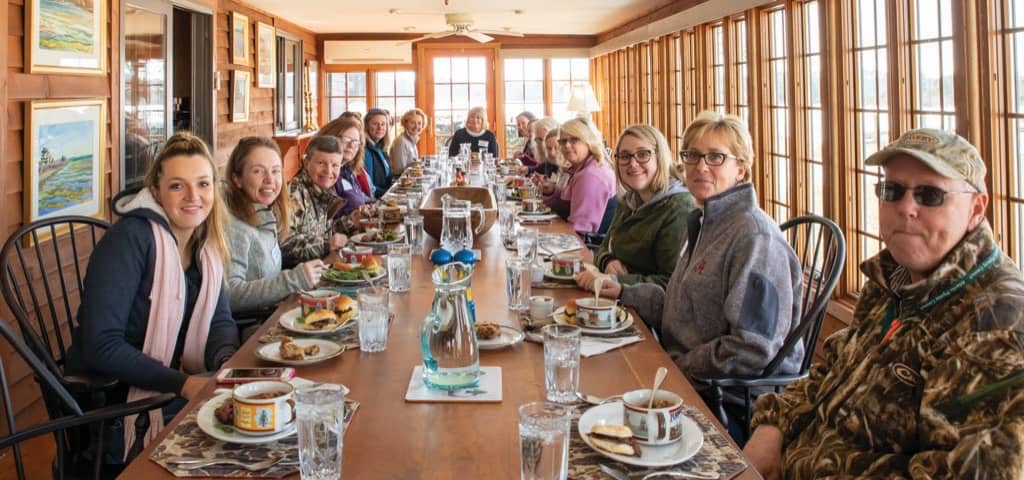
BOW co-coordinator Letha Grimes, a biologist with DNR Fishing and Boating Services, told me the workshops are one-third “consumptive” (hunting and fishing, for example), one-third non-consumptive (such as sporting clay clinics) and one-third “other” (like kayaking instruction). An angler herself, Grimes teaches an annual class in how to filet fish.
Workshops are targeted to women 18 and older. Our group skewed more toward the latter than the former. Men are not necessarily banned from attendance, but BOW workshops strive to foster female camaraderie.
With a welcoming wood fire crackling behind her, Mullaney began the day by gathering us around the lodge’s hearth for coffee and self-introductions. A quintessential Chesapeake gunning club, the one-and-a-half-story building exuded masculinity. There were wooden beams, pine paneling, paintings of wildfowl, deer and a skipjack, plus other hunting lodge hallmarks like wooden decoys, a gunroom as large as most kitchens and, on the other side of the twin-faced brick fireplace, a private bar complete with the envy of any man cave, an indoor grill.
As we settled into large armchairs and a comfy sectional, a variety of waterfowl preserved by a local taxidermist “flew” overhead, suspended from the cathedral ceiling and stirred into motion by ceiling fans. We introduced ourselves and explained our hunting experience (or lack thereof) to a semicircle of new acquaintances.
Four in our group were confirmed hunters, another six were married to hunters or came from hunting families, and a handful such as me had previously shot sporting clays but had never fired upon anything sentient. Our reasons for attending were equally diverse.
A BOW disciple, Roxanne Fleming attended her first workshop about 10 years ago and has become a regular attendee, especially classes involving hunting, fishing, boating and other field sports. She started deer hunting at age 16, goose hunting in her mid 20s and currently owns three Labrador retrievers. “I’ve always had a dog and some kind of firearm in my hands,” she told us. Thanks to friends she’s made at workshops over the years, she now organizes non-BOW goose hunts with her new colleagues in firearms.
Several women signed up primarily for cooking advice from Mullaney, author of the hunting- and family-centric The Lodge at Black Pearl Cookbook. Eva Smorzaniuk married an avid hunter, a passion she hasn’t acquired. She does, however, like to cook, so the two have a natural division of labor, she said: “He kills, I cook.” Another attendee, Shannon Hopkins, spoke for several of her non-hunting sisters when she told Mullaney, “Our freezer is filling up with all this stuff I need to know what to do with.”
One of the best perks of workshop attendance was the chance to learn and sample several of Mullaney’s recipes, dishes she and Cameron prepared on site with our help. (During our morning coffee klatch, wonderful smells and sizzling noises drifted from the kitchen where Cameron was making lunch.) As part of our registration fee, we also received a copy of Mullaney’s cookbook.
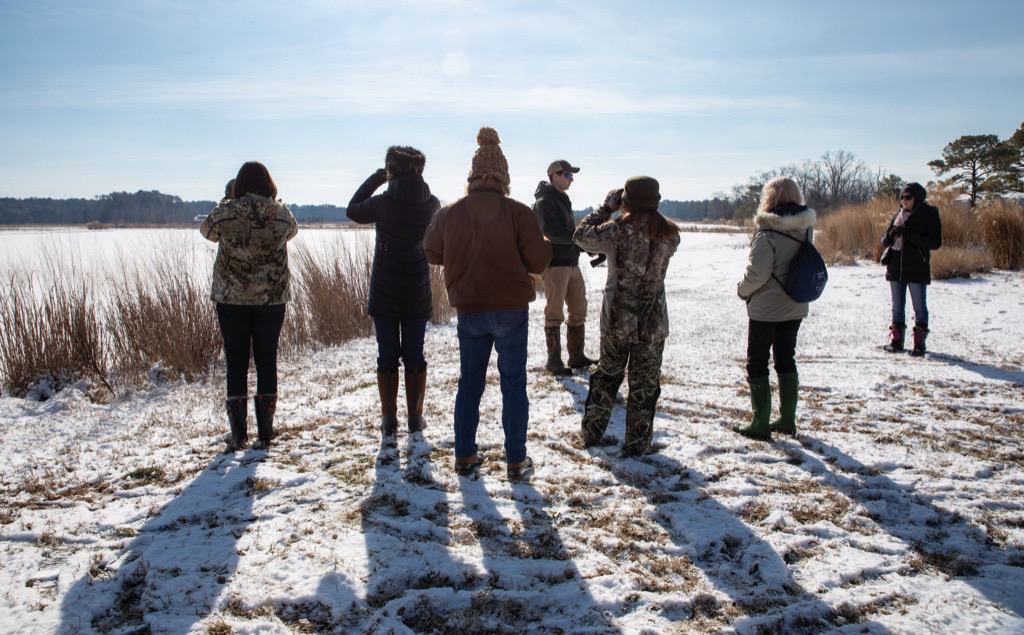
Before we got to the cooking lessons, we needed to learn about our meals-to-be. Rick Walls, a DNR wildlife biologist, provided indoor and outdoor instruction on identifying the variety of ducks, geese, and swans that populate Maryland in midwinter. Walls progressed from Duck 101—teaching us the distinction between shallow-feeding dabbling (puddle) ducks and deeper-feeding diving ducks—to the nuances of their breeding and nesting habits, plumage and flight patterns.
We learned why female ducks (hens) are less colorful than drakes: They need better camouflage because, Walls explained, “the female pretty much does everything.” “Yup!” one woman loudly agreed, accompanied by knowing smiles from the rest of us.
He told us to pay attention to the birds’ flight patterns and noises to better identify them on the wing and in the field. “If there’s quacking going on, I can tell they’re mallards,” he said. Wigeons, on the other hand, make a whistling sound. We received two identification publications to take home, my favorite being a BoatU.S. Foundation pamphlet entitled Know Thy Duck.
To get us started, Walls identified members of the taxidermy flock above our heads. He pointed out a pair of buffleheads hovering above him and some green-winged teal, but admitted he was baffled by a couple of large ducks with dark wings and caramel-colored bodies. They turned out to be ruddy shelducks, a non-native species that hails from Europe and Asia. (I checked; Know Thy Duck also knoweth not this foreign fowl.)
Leaving the fireside, we proceeded outdoors for the field portion of Walls’ lesson. We focused our binoculars on a large, exceedingly talkative flock of mallards clustered on and beside the water some distance away from the lodge. “Do you hear that whistling?” Walls asked. “That’s the drake,” who sometimes makes the noise during courtship displays, he said. “They’ll
puff up and when they come back down, they whistle.”
Apparently conserving their energy in temperatures that rose barely above freezing, the mallards were all squawk and no action, so we peppered Walls with questions. What’s the largest Chesapeake duck? Mallards among puddle ducks, canvasbacks among divers. What are nests made of? Wood ducks use belly down; mallards prefer grasses. What are ducks’ natural predators? “Everything likes the eggs and everything likes ducks. They’re like chickens,” Walls said. Snapping turtles, snakeheads and largemouth bass will eat ducklings, for example. “When you think about it,” he added, “it’s pretty remarkable that any ducks survive at all.” (DNR tries to give them a hand. Wood ducks are Maryland’s primary breeding waterfowl and DNR’s Wood Duck Initiative offers nesting boxes and predator guards for nesting sites on private and public lands.)
For our next lesson, we piled into vehicles and drove along a dirt lane to an old farm field where retired DNR waterfowl biologist Larry Hindman awaited us with Keeper, his precocious yellow Labrador retriever. Hindman breeds and sells retrievers, hunters’ indispensible companions and canine factotums. Without the dogs’ keen noses and disciplined demeanor, he told us, a hunter could lose as many as 25 percent of the birds she or he shoots.
“This dog is a companion,” he said of Keeper, who panted and fidgeted on the portable stand that Hindman used to simulate a hunting blind. “She loves going. It just adds so much to the experience of the hunt.”
Keeper already knew them, but Hindman taught us the terms he uses to direct his dogs. “Sit!” (accompanied by one whistle) was self-explanatory. “Here!” (two or three whistles) means come to me. “Hold!” instructs the dog not to let go of a bird that’s crippled and might escape. “Drop!” signals it’s okay to release the bird.
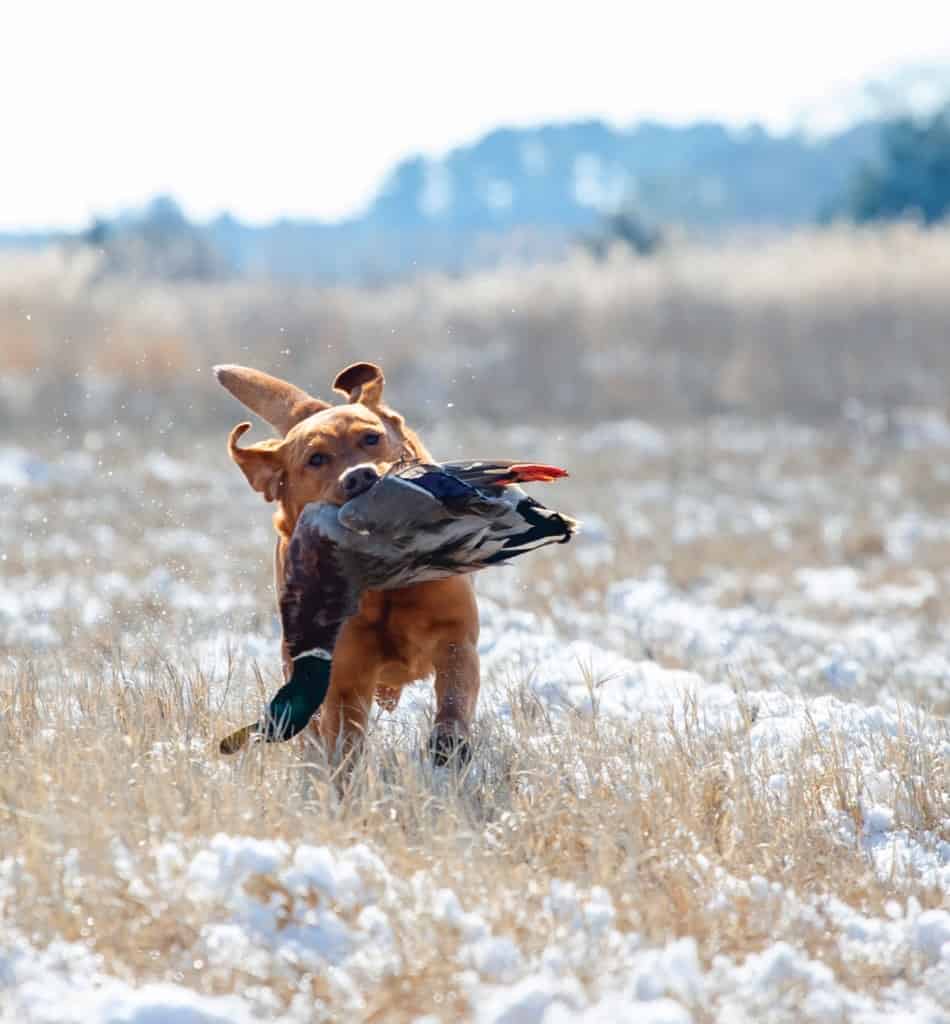
On hearing her favorite command—“Go!”—Keeper dashed off in the direction of a grove of cedar trees where Hindman had hidden several dead mallards. She looked for a few seconds, located a bird and returned lickety-split with it.
Next, he placed a duck in a launcher capable of flinging birds long distances. Using a duck call, he tried to goad Keeper into breaking prematurely. “The longer you wait, the steadier she’ll get,” he said of withholding the “go” command. He launched the duck, finally signaled Keeper and off she went, kicking over the hunting stand in her haste. She found one carcass but overran another. Snow flew as she dashed back and forth in search of the duck. She soon found it and brought it back with all the zeal of a halfback spotting the end zone. “Sit!” Hindman said. “Drop!” She released the bird. “Good dog.”
“Keep,” as he calls her, is one of Hindman’s three retrievers, ranging from eight years to 12 months. All are females and bear the yellow Lab’s original fox red coat color. “Over the years they were bred lighter. I breed this color,” he told us. “For me personally, training a dog from a puppy up to a finished retriever, and [to] see the retrieves she makes, it’s very, very satisfying.”
There’s an old saying among hunters, Hindman later told me: “If you want a good hunting dog get a male; if you want a great hunting dog get a female.” It may not be an absolute truth. “The personality and background of any individual dog are more important factors than sex,” he said. Nonetheless, he decided Keeper was a keeper (as was their older dog, River) because of her alertness (i.e. potential for marking downed birds). I’ll consider that a gender compliment.
Overall across the country, hunting has been in slow decline. After a fairly constant participation rate in the 1980s, the number of hunters fell eight percent between 1990 and 1995, according to the U.S. Fish & Wildlife Service, which surveys Americans’ wildlife-associated recreation habits every five years. In 2011, 13.7 million (15 percent) of residents 16 or older hunted. By 2016, that number was 11.5 million (11 percent).
But more women hunters and a younger generation of health-conscious Americans focused on sustainably procured meats could be reversing the trend. Mullaney cited the nutritional benefits of a wild game diet, most notably the meat’s lower, healthier fat content.
“The animals have an active lifestyle so they’re not very fatty,” she told us. “The fat that they do have is much healthier. The ratio of Omega Six to Omega Three fatty acids is better [than beef’s ratio]. You’re also procuring your own food,” she said, which makes for a smaller carbon footprint than trips to the grocery store. “It’s better for the environment and it’s better for you. You can create delicious, nutritious meals from what you harvest.”
She offered us delicious evidence of the latter. For lunch—eaten in the lodge’s spacious, glass-enclosed dining room overlooking the marshes—we feasted on duck sliders with red onion marmalade, sika deer tenderloins with chimichurri, bowls of hearty gumbo brimming with duck, chicken, sausage and okra, a meal topped off with chocolate pots de crème and apple cake for dessert.
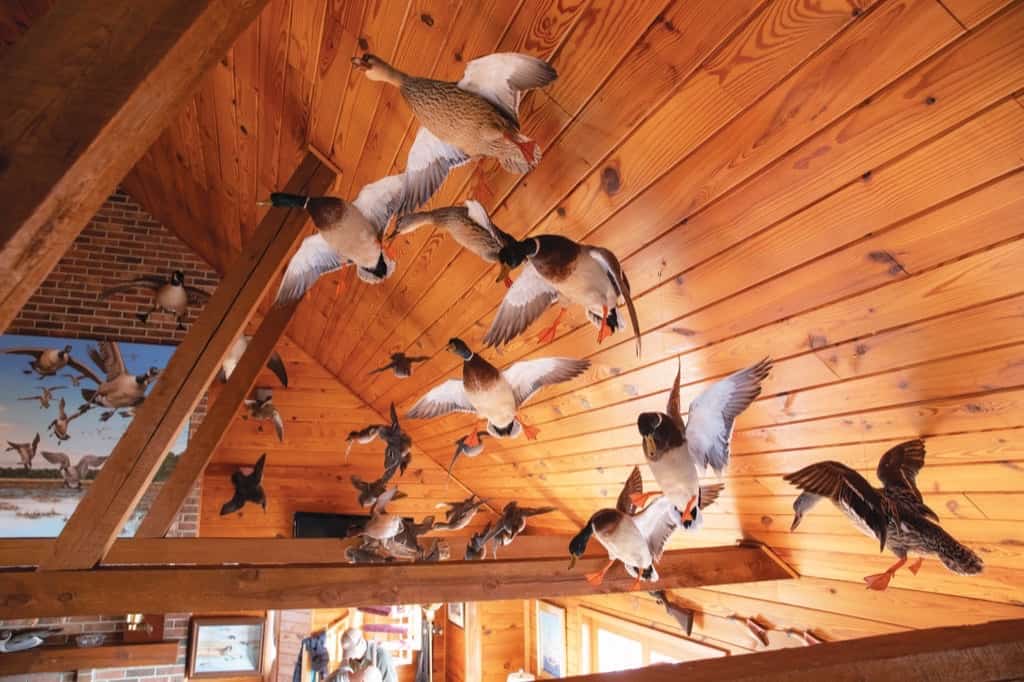
Later, as we continued to cement new acquaintances in the lodge’s bar, Mullaney grilled tender duck breasts like the ones we’d removed while field preparing our mallards. She marinated them in dark rum, ginger and soy sauce, wrapped them in bacon, seared them on the bar’s grill and served the sliced meat with a red currant-mustard dipping sauce. They were meltingly tender, perfectly charred and OMG good. I could get used to this kind of Paleo diet.
“I love to have women here because it’s usually a man’s world,” Mullaney told us before we left—15 better friends, bolder cooks, and budding outdoorswomen.

